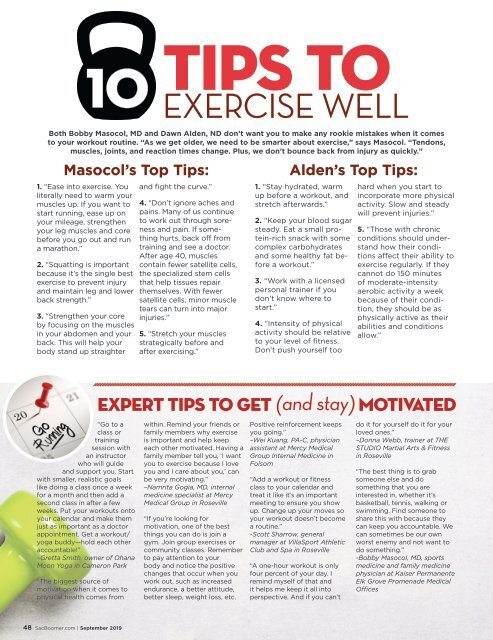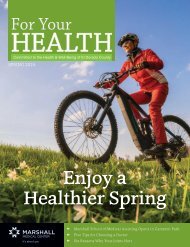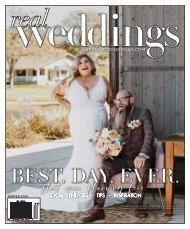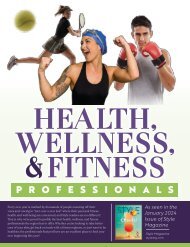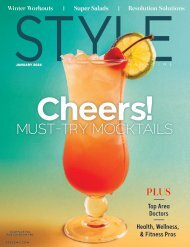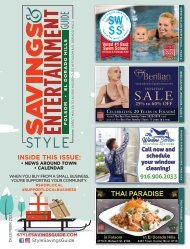BOOMER Magazine: September 2019
Why is it so important to stay in shape as you get older? Why not slow down, sit down, relax, and take it easy–we’ve earned that, right? Nope, wrong. Even though you wanted to reach the next level of fitness and look great in that bikini (or speedo) when you were young, when you get older, staying fit helps you stay ALIVE—kinda important. Our feature article “Fit After 50” (Pg. 40) is chock-full of info on how staying fit helps alleviate so many of those nasty little body breakdowns we all have as we get older. This issue is chock-full of tips on healthy habits, timeless furniture, secret menu items at your favorite restaurants, and more. So enjoy this issue of Boomer for now. Tomorrow we can decide to climb that mountain! By Debra Linn Associate Publisher
Why is it so important to stay in shape as you get older? Why not slow down, sit down, relax, and take it easy–we’ve earned that, right? Nope, wrong. Even though you wanted to reach the next level of fitness and look great in that bikini (or speedo) when you were young, when you get older, staying fit helps you stay ALIVE—kinda important. Our feature article “Fit After 50” (Pg. 40) is chock-full of info on how staying fit helps alleviate so many of those nasty little body breakdowns we all have as we get older.
This issue is chock-full of tips on healthy habits, timeless furniture, secret menu items at your favorite restaurants, and more. So enjoy this issue of Boomer for now. Tomorrow we can decide to climb that mountain!
By Debra Linn
Associate Publisher
You also want an ePaper? Increase the reach of your titles
YUMPU automatically turns print PDFs into web optimized ePapers that Google loves.
10<br />
Tips TO<br />
EXERCISE WELL<br />
Both Bobby Masocol, MD and Dawn Alden, ND don’t want you to make any rookie mistakes when it comes<br />
to your workout routine. “As we get older, we need to be smarter about exercise,” says Masocol. “Tendons,<br />
muscles, joints, and reaction times change. Plus, we don’t bounce back from injury as quickly.”<br />
Masocol’s Top Tips:<br />
1. “Ease into exercise. You<br />
literally need to warm your<br />
muscles up. If you want to<br />
start running, ease up on<br />
your mileage, strengthen<br />
your leg muscles and core<br />
before you go out and run<br />
a marathon.”<br />
2. “Squatting is important<br />
because it’s the single best<br />
exercise to prevent injury<br />
and maintain leg and lower<br />
back strength.”<br />
3. “Strengthen your core<br />
by focusing on the muscles<br />
in your abdomen and your<br />
back. This will help your<br />
body stand up straighter<br />
and fight the curve.”<br />
4. “Don’t ignore aches and<br />
pains. Many of us continue<br />
to work out through soreness<br />
and pain. If something<br />
hurts, back off from<br />
training and see a doctor.<br />
After age 40, muscles<br />
contain fewer satellite cells,<br />
the specialized stem cells<br />
that help tissues repair<br />
themselves. With fewer<br />
satellite cells, minor muscle<br />
tears can turn into major<br />
injuries.”<br />
5. “Stretch your muscles<br />
strategically before and<br />
after exercising.”<br />
Alden’s Top Tips:<br />
1. “Stay hydrated, warm<br />
up before a workout, and<br />
stretch afterwards.”<br />
2. “Keep your blood sugar<br />
steady. Eat a small protein-rich<br />
snack with some<br />
complex carbohydrates<br />
and some healthy fat before<br />
a workout.”<br />
3. “Work with a licensed<br />
personal trainer if you<br />
don’t know where to<br />
start.”<br />
4. “Intensity of physical<br />
activity should be relative<br />
to your level of fitness.<br />
Don’t push yourself too<br />
hard when you start to<br />
incorporate more physical<br />
activity. Slow and steady<br />
will prevent injuries.”<br />
5. “Those with chronic<br />
conditions should understand<br />
how their conditions<br />
affect their ability to<br />
exercise regularly. If they<br />
cannot do 150 minutes<br />
of moderate-intensity<br />
aerobic activity a week<br />
because of their condition,<br />
they should be as<br />
physically active as their<br />
abilities and conditions<br />
allow.”<br />
“Go to a<br />
class or<br />
training<br />
session with<br />
an instructor<br />
who will guide<br />
and support you. Start<br />
with smaller, realistic goals<br />
like doing a class once a week<br />
for a month and then add a<br />
second class in after a few<br />
weeks. Put your workouts onto<br />
your calendar and make them<br />
just as important as a doctor<br />
appointment. Get a workout/<br />
yoga buddy—hold each other<br />
accountable!”<br />
–Gretta Smith, owner of Ohana<br />
Moon Yoga in Cameron Park<br />
“The biggest source of<br />
motivation when it comes to<br />
physical health comes from<br />
Expert tips to get (and stay) motivated<br />
within. Remind your friends or<br />
family members why exercise<br />
is important and help keep<br />
each other motivated. Having a<br />
family member tell you, ‘I want<br />
you to exercise because I love<br />
you and I care about you,’ can<br />
be very motivating.”<br />
–Namrita Gogia, MD, internal<br />
medicine specialist at Mercy<br />
Medical Group in Roseville<br />
“If you’re looking for<br />
motivation, one of the best<br />
things you can do is join a<br />
gym. Join group exercises or<br />
community classes. Remember<br />
to pay attention to your<br />
body and notice the positive<br />
changes that occur when you<br />
work out, such as increased<br />
endurance, a better attitude,<br />
better sleep, weight loss, etc.<br />
Positive reinforcement keeps<br />
you going.”<br />
–Wei Kuang, PA-C, physician<br />
assistant at Mercy Medical<br />
Group Internal Medicine in<br />
Folsom<br />
“Add a workout or fitness<br />
class to your calendar and<br />
treat it like it’s an important<br />
meeting to ensure you show<br />
up. Change up your moves so<br />
your workout doesn’t become<br />
a routine.”<br />
-Scott Sharrow, general<br />
manager at VillaSport Athletic<br />
Club and Spa in Roseville<br />
“A one-hour workout is only<br />
four percent of your day. I<br />
remind myself of that and<br />
it helps me keep it all into<br />
perspective. And if you can’t<br />
do it for yourself do it for your<br />
loved ones.”<br />
–Donna Webb, trainer at THE<br />
STUDIO Martial Arts & Fitness<br />
in Roseville<br />
“The best thing is to grab<br />
someone else and do<br />
something that you are<br />
interested in, whether it’s<br />
basketball, tennis, walking or<br />
swimming. Find someone to<br />
share this with because they<br />
can keep you accountable. We<br />
can sometimes be our own<br />
worst enemy and not want to<br />
do something.”<br />
-Bobby Masocol, MD, sports<br />
medicine and family medicine<br />
physician at Kaiser Permanente<br />
Elk Grove Promenade Medical<br />
Offices<br />
48 SacBoomer.com | <strong>September</strong> <strong>2019</strong>


